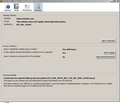
I updated firefox, how can I confirm that my connection is secure?
I cannot connect to Social Media sites, YouTube, Google, any of my email sites, or even Mozilla.org using the firefox browser after the latest update.
"This Connection is Untrusted
You have asked Firefox to connect securely to support.mozilla.org, but we can't confirm that your connection is secure.
Normally, when you try to connect securely, sites will present trusted identification to prove that you are going to the right place. However, this site's identity can't be verified."
It worked fine until I updated today, and I have to use Google Chrome to contact you. Please help me out, because going back to Internet Explorer would be a major letdown.
Сви одговори (10)
Can you attach a screenshot?
- http://en.wikipedia.org/wiki/Screenshot
- https://support.mozilla.org/kb/how-do-i-create-screenshot-my-problem
- Use a compressed image type like PNG or JPG to save the screenshot
- Make sure that you do not exceed the maximum size of 1 MB
Gee, how do you make a screenshot? All Greek to me This is going to be a big waste of time but here they are:
Hi jakester, you're close. If you click View Certificate then you may be able to get more information about the entity named DO_NOT_TRUST which issued the certificate.
Or we could just assume that it is the DO_NOT_TRUST_FiddlerRoot certificate typically used by malware such as BrowserSafeguard (or some variation on that name) which you can remove through the Windows Control Panel, either Uninstall a Program, or on XP, Add or Remove Programs.
Some supplemental security scans also wouldn't hurt. Our support article recommends free tools other Firefox users have found helpful: Troubleshoot Firefox issues caused by malware.
If you think this problem started around the time of your last upgrade, can you check your download history to see whether you got an unofficial installer?
The "do not trust" is because i added it as an exception How would malware just affect one browser and not even try to redirect me or anything The FAULT IS IN FIREFOX, not external I uninstalled FF and deleted all the reg entries, but the same set up kept resurfacing like a bad dream every time I reloaded it. FF sucks, period, but I really need it to work right And every upgrade came from FF browser. So that had to be compromised to if your "Malware" hypotheses has any validity It seems you people are like PR agents, who are more interested in blaming someone else or me than examining the problems with FF
Измењено
Hi jakester, someone posts this identical problem every week, so I think we recognize the symptoms by now.
Why not go into your other browsers that you trust to be handling this correctly, click the padlock when you're on YouTube, and see what issuer shows up there. Does IE, Chrome, or Opera show the correct information for YouTube? (Screen shot re-attached for quick reference.)
Here it is for your perusal, from Cr
You have malware on your computer that has installed a certificate called "FIdderlerroot" (Notice how it says "DO_NOT_TRUST_Fiddlerroot).
Please read Troubleshoot Firefox issues caused by malware
Also go into your control panel and uninstall BrowserSafeguard if it exists.
You are most likely installed the web debugging tool Fiddler2(?) and asked for it to use its own certificates so that you can debug https traffic
see: http://www.fiddlerbook.com/fiddler/help/httpsdecryption.asp
I uninstalled some garbage like Rocket Tabs and all of a sudden, the SSL worked fine. IDK
Hi jakester, thank you for reporting back.
For anyone else following this, for help removing Rocket Tab, see: http://malwaretips.com/blogs/rockettab-virus-removal/




